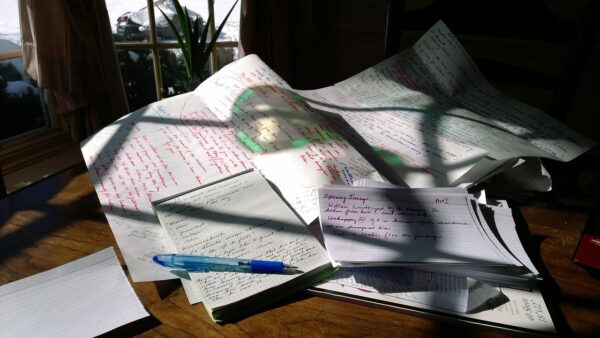If you plan to have your work published, it is essential to find a good copy editor to help ensure that it meets all the requirements. While there are some similarities between copy editing and proofreading, the two tasks are not the same.
A proofreader will typically read through a document multiple times to find and correct any errors. A copy editor, on the other hand, will not only look for errors but also suggest changes to the overall structure and content of the piece.
This blog post will discuss copy editing and how it differs from proofreading. We will also provide some examples to help illustrate these concepts.
What is copy editing, and the difference between copy editing and proofreading?
– Copy editing (also known as line editing or manuscript editing) is the process of reviewing and correcting written material to improve accuracy, readability, and fitness for its purpose.
The main objective is to ensure that the writing is clear, accurate, and ready for publication. This process involves meticulously reviewing the text and making changes to improve grammar, style, syntax, flow, etc.
– Proofreading is checking a document for spelling, grammatical errors, and punctuation mistakes.
The main difference between these two processes is that copy editing focuses on improving the overall quality of the text. In contrast, proofreading focuses on catching any errors you may have missed.
What are the steps of the copy editing process?
The steps of the copy editing process can vary depending on the project and the copy editor. However, there are some common steps that most copy editors will take when working on a document.
These steps include:
– Reading through the entire document to get a general understanding of its content.
– Identifying any areas that need clarification or improvement.
– Making changes to the text, such as correcting errors or improving clarity.
– Review the document after making changes to ensure that it meets the required standards.
Copy editing is an integral part of the publishing process. By providing that a paper is well-written and free of errors, a copy editor can help to improve its overall quality.
Once the copy editing process is completed, the proofreader will take over as the last step before a document is published. During this process, the focus is on catching any remaining formatting errors or typos.
The benefits of copy editing
There are many benefits to having your work copy edited. Perhaps the most obvious benefit is that it can help improve the overall quality of your writing.
By ensuring that your work is free of errors, you can help ensure that it will be taken more seriously by publishers and readers alike.
Another benefit of copy editing is that it can help to improve the clarity of your writing. A good copy editor can point out areas where your meaning is unclear and suggest ways to make your writing more accessible to your audience.
Three examples of copy editing done in my novel The Price of Silence:
1. Rounding a bend, their kayaks were pulled along by the current.
Copy editor: Rounding a bend, Amy felt the tug of their kayak being pulled along by the current.
2. The morning was cool with aromas of fall.
Copy editor: The morning was cool, with a hint of fall in the air.
3. Amy realized this was not a Tyler threat—this was a threatening situation.
Copy editor: Amy realized that this wasn’t Tyler himself threatening her—this was a threatening situation.
Excerpt from a book that has been copy edited and proofread

Here are the opening pages of William Golding’s Lord of the Flies. The novel begins with a plane crash, and the ensuing chaos is described in precise detail. Golding’s writing is razor-sharp, and his command of language is masterful. The result is a beautifully written novel that’s impossible to put down.
Chapter One: The Sound of the Shell
“The boy with fair hair lowered himself down the last few feet of rock and began to pick his way towards the lagoon. Though he had taken off his school sweater and trailed it now from one hand, his grey shirt stuck to him, and his hair was plastered to his forehead. All round him the long scar smashed into the jungle was a bath of heat. He was clambering heavily amongst the creepers and broken trunks when he heard the noise for the first time.
It was a queer, blowing sound that seemed to come from far away and get closer every moment. Now it became a continuous noise that filled the air with a high whiney humming. The next instant, he was enveloped in a cloud of steam.
The noise was deafening. It seemed to come from all round him and yet it was inside his head too. He put his hands over his ears, and still, the sound drilled into them. What was happening? What could he do? Then he saw the thing.
It was a great insect, as big as a man, and it was coming straight at him through the air, its wings making that queer noise. It had two round eyes in front and two long feelers that waved about as it flew. As it came nearer, he could see its mouthparts working greedily.
He turned to run, but it was too late. The insect was upon him. He felt its long feelers winding round him, and he screamed as its powerful jaws closed on his arm.”
So there you have it: a brief explanation of copy editing, the difference between copy editing and proofreading, and some examples. As you can see, both steps are essential in the editing process, and both play a vital role in ensuring that your document is error-free and precise.
So if you’re ever unsure about which step to take, remember: if it’s something that could be considered an error, proofread it; if it’s something you could improve, copy edit it. And of course, if you’re ever in doubt, always consult with a professional editor. They’ll be able to help you determine what needs to be done to make your document the best it can be.
Exceptions to proofreading and copy editing rules
While there are general rules that copy editors and proofreaders follow, there are always exceptions to the rule. For example, one common exception is when it comes to quotation marks. Generally speaking, British English uses single quotation marks (”) while American English uses double quotation marks (“”). However, there are always exceptions to this rule.
Another exception has to do with ellipses. Ellipses are those three little dots (…) that indicate something has been left out. The rules for using ellipses are pretty specific and can vary depending on your style guide.
Of course, these are just a few examples. There are many, many more rules when it comes to copy editing. And, as with anything, the more you do it, the easier it becomes. So don’t be discouraged if it seems overwhelming at first. Take it one step at a time, and soon you’ll be a pro!
How to choose a professional copy editor and proofreader

When selecting a proofreader or copy editor, there are a few things you should keep in mind.
First, what level of editing do you need? If you’re not sure, ask yourself these questions:
– Are there any significant issues with the overall structure of the piece?
– Is the tone appropriate for the audience?
– Are there any factual errors?
– Is the writing clear and free of grammar and spelling errors?
You would need a copy editor if you answered yes to any of these questions. A copy editor will do all of the above, plus fact check, catch continuity errors, and make sure your characters are consistent.
Conclusion
I hope this has helped clarify some confusion around copy editing and proofreading. If you are looking for a professional copyeditor and proofreader, be sure to do your research and find someone who meets your needs. If you have any questions, feel free to leave a comment below or get in touch with me directly. I’m always happy to help!
If you’re working on your first novel and are looking for more help with your writing, please check out our other articles at https://ullahakanson.com/blogs/
Thanks for reading!
Ulla

